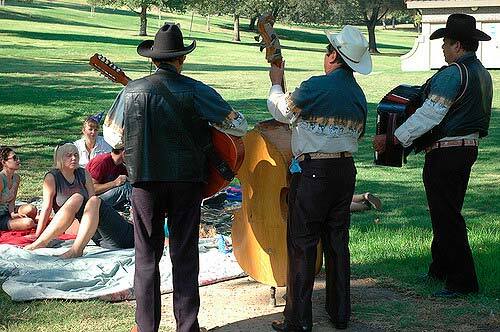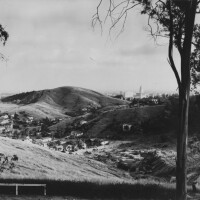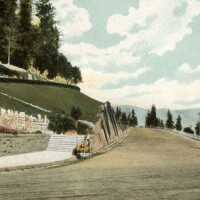Elysian Park: A Plaza Set in Nature

“Why don’t you buy a bottle of wine and take us to Elysian Park?” I once asked my parents when I was 8 years old.
As a little Angeleno, a trip to Elysian Park was just as exciting as going to Disneyland or the beach. The twists and turns from the winding roads and overlooks from the parks hills reshuffled my familiar views of L.A.’s East Side. City Hall, the freeways, the L.A. River and its bridges danced around as I gazed out the window.
The Mexican-American experience with Elysian park started a few generations before, however, during the late 1950s and early 1960s when for the upwardly mobile, like my family, Elysian Park was the place for young adults to see and been seen or children to explore nature. A vast majority of Angelenos at this time were hunkering down into their backyards in the new far-flung suburbs, Mexican-Americans by contrast donned their Sunday best and headed to Elysian Park.
While Elysian Park was designed to enjoy the great outdoors through topography and landscape, for many Mexican Americans it became a space for socialization and cultural appropriation: a plaza set in nature!
It was a short drive for most Mexican-Americans, who, for a few hours, could unwind, chit-chat with girlfriends, make new friends, pick-up baseball games, have birthday parties, family gathering, barbecues — or just take the kids to yell and scream.
It became the place to express their cool and display their new prosperity through cars, clothing, music, and socializing among their peers. On Sundays, women did their hair, wore skirts, capris while men wore slacks, shirts and French toe shoes. No t-shirts, flip flops or tennis shoes.

HISTORY

Elysian Park’s hilly topography rises above the L.A. Basin and is at a pivotal point where the L.A. River enters the narrows or Elysian Valley. This gives the park it’s visual prominence and strategic central location for L.A.’s growing Mexican-Americans population living in along the L.A. Riverflood plain or adjacent neighborhoods atthattime.
These communities included Lincoln Heights, the Avenues, Boyle Heights, El Pueblo, Pico Aliso, Frog Town, Echo Park, Cypress Park, Alpine and Chinatown. Or a few of my family members lived in the rugged landscape shared by the park at Chavez Ravine. The neighborhoods of Palo Verde, Bishop and La Loma that compromised Chavez Ravine were older than the park itself.
The creation of Elysian and Griffith Parks were similar to the creation of Washington D.C’s. Rock Creek Park, New York City’s Central Park or San Francisco’s Golden Gate Park that were created to showcase the wilds of nature, sometimes with a little help from designers.
As soon as Elysian park was established in the late 19th century, however, L.A.’s middle class residential development started migrating westward, abandoning L.A.’s older neighborhoods and parks. For this demographic, Griffith Park became the park of choice. Griffith Park was much larger than Elysian Park, and it’s mini-mountains provided views of the city’s western development and the San Fernando Valley. The tony neighborhood of Los Feliz, and Hollywood shared the same landscape. The city also invested in Griffith Park through the zoo, observatory, and the Greek Theater.
The three discrete entrances to Elysian park from Chinatown/North Broadway, Riverside Drive or from Echo Park are not well marked. This makes it difficult to access for people not in the know. For decades, Elysian Park remained relatively forgotten by the civic leaders and middle class Angelenos until the destruction of Chavez Ravine and building of Dodge Stadium. The relative isolation of Elysian Park created the ideal civic, public domain for L.A.’s Mexican-American and other inner-city residents. My aunt recalls that by the mid fifties, when she went to Elysian Park, she remembers seeing mainly Mexican-Americans and African Americans. They could leave their small apartments and homes to unwind, and relax with family and friends.
Elysian Park was a respected gang neutral zone where the hand of nature erased their urban turfs.
Design

The park’s dry, dusty, chaparral landscape dotted with palms, small trees, bushes and lawns was a landscape many Mexican-Americans were familiar because it resembles the Southwest and northern Mexico were many migrated from. This flexible landscape was a blank canvas
thatprovided endless opportunities for uses and social expressions by its patrons.
Elysian Park was not like Hollenbeck, Lincoln, McArthur, Echo Park, and other intercity parks near where Mexican-American lived at that time. These highly manicured, passive urban parks were relatively small, and designed with lakes, exotic plants. They were 19th century relics that embedded bits and pieces of East Coast and Midwest landscape aesthetics, infused into the Southwest.
The fine-grained landscape details of these parks created a controlled environment that promoted certain interactions with nature and other people. Even though Mexican-Americans lived around these parks and used them, there was, however very little room for improvisation and new forms of cultural expression.
Racism against Mexican-Americans existed in L.A. at this time in the forms of red lining and police harassment; however, for this generation who grew up during World War II and the Korean War, Elysian Park became a place to shed the old Mexican traditions and embrace their American identity and prosperity.
Alcoa Steel, Goodrich, Norris Industries, Farmer Johns, and plenty of other manufacturing companies were located in or on the flat lands near the L.A. River close to where Mexican-Americans lived or visa versa. L.A.’s manufacturing was at its peak and needed manual labor. This attracted Mexican American men like my father who dropped out of high school to enter the working world and start a family. Married at 18 years of age, and by 24 he had four children and could purchase a home and new cars!
For Mexican-American young women, they could find a cozy spot to talk with their girlfriends, or make new friends.

Car Culture
For Mexican-American men, Elysian Park became the place to show off their cars and use it as a socializing tool through cruising. At this time in L.A., there was cheap gas, little traffic, plenty of parking, and plenty of curvy roads ideal for driving. Mexican-American men embraced the park's roadways: they would take pride in their cars, cruise, flirt, or find a nice spot to park and primp their car. The sounds of Joe Tuner, Etta James and other rhythm and blues tunes was the music of choice for this generation of Mexican-Americans which embraced African American music.
Elysian Park provided an important spacea multi-generational park.
It was unsupervised fun!! And as my aunt put it — the only time she saw law enforcement was after curfew!
From pick up baseball games, cruising, barbecues and birthday celebrations, hanging out Elysian Park provided an important space — a multi-generational park. While teenagers hovered over the roads, young families enjoyed the spreading lawns where they picnicked and the children like myself could run wild and let your imagination go!

ME
Growing up gay, I found bliss in the healing power of nature. However I hated to visit parks that were only designed for organized, competitive sports fields like baseball diamonds, or basketball courts. One time, my parents tried to enroll me in Pop Warner football, which proved disastrous!
My back yard was climbing trees, smelling flowers, collecting bugs and building imaginary cities in the dirt. By contrast Elysian Park was a raw, undiscovered and a full body experience. It offered to me nature at a different scale because it lacked the order and fine grain details of my back yard landscape I was used to. I was able to run boundlessly, roll down the slopes, seek shelter in bushes or under the tree canopy.
My family would set up the picnic blankets on the lush green lawns, that would give way to sage bushes and trees of the hillsides. I would explore with my siblings and cousins where my imagination would run wild. We would tell ourselves the story of La Llorona, a female ghost who cries looking for her dead children!
With the construction of Dodger Stadium and as Mexican-Americans moved further east to more affluent communities and larger homes, by the late 1960s Elysian Park began to change. As for me, now that I have seen the wonder of nature across the U.S., this scrappy landscape does not compare, but to a tiny Angeleno it provided a safe haven!


